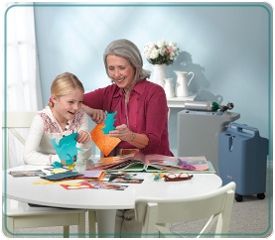Asthma and Allergy-free Vacations
 If you're planning a vacation, and you or your child have allergies or asthma, proper planning can help you keep sneezes, sniffles, wheezing, and coughing under control. Use the following tips as a checklist from the American College of Allergy, Asthma and Immunology (ACAAI) to make sure that allergy misery doesn't derail your vacation fun.
If you're planning a vacation, and you or your child have allergies or asthma, proper planning can help you keep sneezes, sniffles, wheezing, and coughing under control. Use the following tips as a checklist from the American College of Allergy, Asthma and Immunology (ACAAI) to make sure that allergy misery doesn't derail your vacation fun.Do your Homework:
- Check weather and pollen forecasts for your U.S. vacation choices, then plan accordingly. For example, if you're allergic to ragweed, New York can be significantly better early in August rather than later.
- Consider the beach or mountains. These locations are best bets for allergy sufferers any time of year. Ocean breezes are generally free of allergens, and dust mites don't thrive at elevations above 2,500 feet. Mold spores are killed by snow.
- Talk to your allergist. This is especially important if you are going to travel abroad and may need vaccinations or immunizations. You also may want to talk to your allergist about where you're going and what activities you may do. For example, locations with elevations above 5,000 feet may make breathing difficult and cold weather can be a trigger for asthma patients. Asthma patients also should discuss activities like scuba diving.
- Check access to medical care. If you are going to a remote location or on a cruise, you should inquiry about the type of medical care available.
Check Lodging Options:
- Request a non-smoking room with air conditioning (a little more difficult when traveling abroad).
- Check availability of a portable HEPA air purifier or HEPA filters for your room's air conditioner.
- Find out if wood, tile or seamless vinyl floors are available (a little less difficult when traveling abroad). Carpeting can be a breeding ground for dust mites.
- Consider renting a room with a kitchen or shipping food ahead if you have food allergies.
Pack your Suitcase:
- Medications. Don't forget to put them in your carry-on luggage — and in the original bottles to avoid questions from airport security and customs agents. Make sure you pack quick-relief medications for asthma and an epinephrine kit if you or a family member has food or insect sting allergies. You also might want to bring a topical hydrocortisone cream and an over-the-counter antihistamine.
- Shots. If you're being treated with allergy shots, make sure you get your scheduled shot before you leave. If you will be traveling for more than a few weeks, ask your allergist to provide a treatment dose to take with you, and the name of a local allergist who can give you the shot.
- Pillowcase. Consider packing your mite-proof pillowcases to help keep dust mites under control.
- Peak flow meter and nebulizer. These can help you monitor your breathing and deliver medication. Many nebulizers come with an adaptor you can plug into your car. If you are traveling abroad, make sure you bring an adaptor to convert the electrical current.
- Wipes for trays and tables. This can help protect travelers with food allergies.
- Translated information on your allergies. This can be shared with a chef when dining out in a foreign country.
Continue reading "Asthma and Allergy-free Vacations"
 Living with COPD can be challenging, as the disease dramatically impacts your daily life. Often causing severe disability, a diagnosis of COPD can lead to feelings of hopelessness and helplessness.
Living with COPD can be challenging, as the disease dramatically impacts your daily life. Often causing severe disability, a diagnosis of COPD can lead to feelings of hopelessness and helplessness.